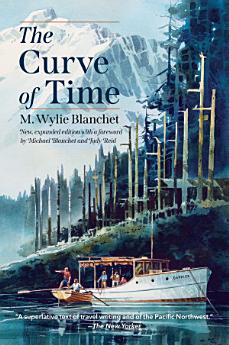The Curve of Time: New, Expanded Edition
About this ebook
Widowed at the age of thirty-five, Muriel Wylie Blanchet packed up her five children in the summers that followed and set sail aboard the twenty-five-foot Caprice. For fifteen summers, in the 1920s and 1930s, the family explored the coves and islands of the BC coast, encountering settlers and hermits, hungry bears and dangerous tides, and falling under the spell of the region’s natural beauty.
Driven by curiosity, the family followed the quiet coastline, and Blanchet—known as Capi, after her boat—recorded their wonder as they threaded their way between the snowfields, slept under the bright stars and wandered through Indigenous winter villages left empty in the summer months.
The Curve of Time weaves the story of these years into a memoir that has inspired generations to seek out their own adventures on the wild west coast. First published in 1961, less than a year before the author died, Blanchet’s captivating work has become a classic of travel writing, and one of the bestselling BC books of all time.
Ratings and reviews
- Flag inappropriate
About the author
M. Wylie Blanchet (1891-1961) was born in Montreal and spent her childhood as an avid seeker of the natural world. Her adventurous and independent spirit led to extraordinary summers with her children exploring the coastal wilderness of British Columbia, and her recollections of the landscape have earned her memoir, The Curve of Time, a place in Canadian literature as an enthralling West Coast must-read. Her children’s book, A Whale Named Henry, was originally published posthumously by Harbour Publishing in 1983. Blanchet passed away at her home near Sidney, BC, at the age of seventy.
Edith Iglauer was born in Cleveland, Ohio. She married Philip Hamburger and raised two sons in New York. A frequent contributor to the New Yorker, she has written a great deal about Canada. Her first book, The New People (1966, reprinted and updated as Inuit Journey in 1979 and 2000) chronicled the growth of native cooperatives in the eastern Arctic. She profiled Pierre Trudeau in 1969 and internationally known architect Arthur Erickson in 1979. Denison’s Ice Road is about the building of a 325-mile winter road above the Arctic Circle. Divorced in 1966, she came to Vancouver in 1973. She married John Heywood Daly, a commercial salmon troller and moved to Garden Bay on the BC coast. Daly died in 1978. After writing Seven Stones: A Portrait of Arthur Erickson, Architect (1981) she began recording her memories of her late husband and his salmon troller the MoreKelp. The result was Fishing with John, a runaway bestseller and nominee for the 1989 Governor General’s Award for Non-Fiction. Her second memoir, about her career in journalism, was The Strangers Next Door.
Howard White was raised in a series of camps and settlements on the BC coast and never got over it. He is still to be found stuck barnacle-like to the shore at Pender Harbour, BC. He started Raincoast Chronicles and Harbour Publishing in the early 1970s and his own books include A Hard Man to Beat, Spilsbury’s Coast, The Accidental Airline, Writing in the Rain, The Sunshine Coast and A Mysterious Humming Noise (Anvil, 2019). In 2000, he completed a ten-year project, The Encyclopedia of British Columbia. He has been awarded the Order of BC, the Canadian Historical Association’s Career Award for Regional History, the Stephen Leacock Medal for Humour, the Jim Douglas Publisher of the Year Award and a Honorary Doctorate of Laws Degree from the University of Victoria. In 2007, White was made an Officer of the Order of Canada.





